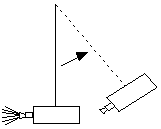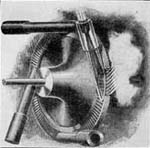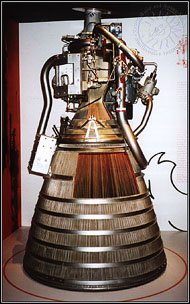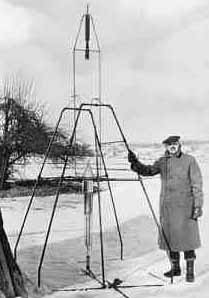(26) Robert Goddard and His RocketsEarly RocketsRockets were invented by the Chinese, a spin-off from their invention of gunpowder--some time around the year 1000, perhaps earlier. Rockets added a new dimension to fireworks--another Chinese contribution--but, invevitably, they were also applied to warfare, as missiles to set the enemy's cities on fire. The British took notice in 1791, when Indian troops, under Tipoo Sultan, employed rockets against them. William Congreve, a British officer, developed a military rocket and in 1806 urged its use against Napoleon. "The rocket's red glare" in the US anthem refers to the use of Congreve rockets in 1814 in an unsuccessful British attack on Fort McHenry, outside Baltimore. The aim of such rockets was notoriously inaccurate, and their use declined as artillery improved. However, commercial rockets were sold for use by ships, for carrying a line to the shore in case of shipwreck. Still, rockets were the only credible way of reaching distant space. One visionary who realized this was Konstantin Tsiolkovsky (1857-1935), a Russian teacher who enthusiastically promoted spaceflight and wrote books on the subject, long before the idea received serious consideration. GoddardAnother was a young American, Robert Hutchins Goddard (1882-1945). A native of Worcester, Massachusetts, Goddard's family was staying at the suburban home of friends in Worcester when, on October 19, 1898, he climbed into an old cherry tree to prune its dead branches. Instead, he began daydreaming on ". . . how wonderful it would be to make some device which had even the possibility of ascending to Mars. " That was when young Goddard decided to pursue the idea of spaceflight, and in later years he observed October 19th as his personal "anniversary day." He later wrote "I was a different boy when I descended the tree from when I ascended, for existence at last seemed very purposive." Goddard's first rocket experimentsNearly eighteen years later, as assistant professor at Clark University, Worcester, he began examining the feasibility of that dream. He bought some commercial rockets and measured their thrust using a ballistic pendulum, a heavy mass suspended by ropes, to which the rocket was attached. The rocket was fired, and the height to which the pendulum rose provided a measure of the total momentum (mass times velocity) imparted to it. 
It can be shown from Newton's laws that the total momentum of a system free from outside forces is conserved; that is actually another formulation of the conservation of the center of gravity, mentioned in the discussion of rocket propulsion. Therefore the momentum given to the pendulum in one direction had to be equal to the momentum mv imparted to the rocket's gas jet and that momentum determined the length and height of its swing. By weighing the rocket before and after firing, Goddard could derive the mass m of the ejected gases and from that deduce v. For a 1-pound Coston ship rocket, he found that v was about 1000 ft/sec (300 m/sec). De Laval's NozzleA rocket is essentially a heat engine, a device for converting the energy of heat (obtained from the chemical energy of the fuel) into mechanical energy--here the kinetic energy mv2/2 of its exhaust jet. Knowing m and v, Goddard could derive the kinetic energy given to the gas, and by burning a measured amount of the fuel, absorbing the heat (e. g. in water) and measuring the rise in temperature, the total amount of chemical energy converted to heat could also be obtained. The conclusion was rather disappointing: only about 2% of the available energy contributed to the speed of the jet. Could this be improved? Luckily for Goddard, this problem had been solved by Gustav De Laval, a Swedish engineer of French descent. In trying to develop a more efficient steam engine, De Laval designed a turbine whose wheel was turned by jets of steam.
The critical component, the one in which heat energy of the hot high-pressure steam from the boiler was converted into kinetic energy, was the nozzle from which the jet blew onto the wheel. De Laval found that the most efficient conversion occured when the nozzle first narrowed, increasing the speed of the jet to the speed of sound, and then expanded again. Above the speed of sound (but not below it! ) this expansion caused a further increase in the speed of the jet and led to a very efficient conversion of heat energy to motion. Nowadays steam turbines are the preferred power source of electric power stations and large ships, although they usually have a different design--to make best use of the fast steam jet, De Laval's turbine had to run at an impractically high speed. But for rockets the De Laval nozzle was just what was needed. Goddard experimented on his ballistic pendulum with various nozzle designs, using a small metal combustion chamber filled with a type of gunpowder, ignited by electricity. The end of the chamber was threaded, so that nozzles of various designs could be screwed onto it and tested. Using a De Laval nozzle, he obtained jet velocities between 7000 and 8000 ft/sec and efficiencies of up to 63%. As Goddard himself noted, that made the rocket the most efficient of all heat engines, better than piston-driven steam engines (21%) and Diesel engines (40%). No wonder: from the second law of thermodynamics, the theoretically attainable efficiency of a heat engine increases with its operating temperature, and no other heat engine runs as hot as a rocket.
After the US entered World War I, Goddard also worked for a while on military rockets, but none of his designs were implemented, though rockets somewhat similar to his design were turned in World War II into an effective weapon against tanks, known as the bazooka.
On March 16, 1926, Goddard flight-tested his first liquid-fuel rocket. He thought stable flight could be obtained by mounting the rocket ahead of the fuel tank, with the tank shielded from the flame by a metal cone and the lines for fuel and oxygen pulling it behind the rocket: the design worked, but did not produce the hoped-for stability. The rocket burned about 20 seconds before reaching sufficient thrust (or sufficiently lightening the fuel tank) for taking off. During that time it melted part of the nozzle, while the camera with which Mrs. Esther Goddard was trying to record the flight ran out of film, so that no photographic record of that flight remains. Then it took off to a height of 41 feet, leveled off and later hit the ground, all within 2. 5 seconds, averaging about 60 mph. Goddard's concept seemed validated, but he was still far from a practical design. Unfortunately, he worked in isolation, without the engineering resources of a major institution. In the years that followed he continued developing his rockets--controlling their motion by gyroscopes, steering them with small vanes thrust into their exhaust jet, and building larger and faster rockets. These were tested in test stands on the ground and sometimes also in free flight, mostly at a rocket lab he established in Roswell, New Mexico. But the actual realization of his dream fell to others who enjoyed military or national support. Goddard, unfortunately, never lived to see the age of spaceflight. He died of cancer on August 10, 1945, in Baltimore. |





